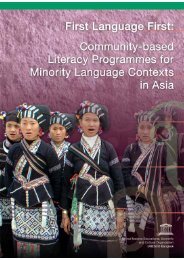Part II.pdf - MTB-MLE Network
Part II.pdf - MTB-MLE Network
Part II.pdf - MTB-MLE Network
You also want an ePaper? Increase the reach of your titles
YUMPU automatically turns print PDFs into web optimized ePapers that Google loves.
tongue. Regional LWCs, as well as local vernaculars, are widely used around the country. A large<br />
proportion of Indonesians speak Indonesian as a second language with varying levels of proficiency.<br />
Languages such as Javanese, Madurese and Sundanese, for example, are spoken by tens of millions<br />
of people, and several other languages have millions of native speakers (Grimes 2000; Dardjowidjojo<br />
1998; Jernudd 1999; Leclerc 2004e; Kaplan & Baldauf 2003; Walter & Ringenberg 1994).<br />
The Indonesian Constitution guarantees the use and development of local languages. An education<br />
act supports the use of students’ mother tongue as the media of instruction in the first three years<br />
of elementary school while Indonesian is being taught as a subject. In practice, however, local<br />
languages are rarely used in government schools, and in most cases, instruction begins and continues<br />
in Indonesian. Major regional languages were used prior to 1965 as the media of instruction, but<br />
currently, these and other local languages are mainly taught as second languages. Sometimes even<br />
the old learning materials are used (Dardjowidjojo 1998; Jernudd 1999; Kaplan & Baldauf 2003;<br />
Leclerc 2004e; K. Ringenberg, pers. comm. 2003).<br />
The use of local languages in the formal school system is, thus, restricted to an elective course in<br />
elementary grades below Grade 9 (Kaplan & Baldauf 2003; Leclerc 2004e). Local communities<br />
can contribute to this specific “locally generated curriculum,” and local languages can be used in<br />
this curriculum if communities so choose. In some areas, local language materials with Indonesian<br />
translations are produced for this curriculum. Local languages are more widely used in non-formal<br />
education, particularly in adult literacy. Local language committees and NGOs are, indeed, playing<br />
important roles in the development of local languages and in the production of literacy materials<br />
for such languages (Dardjowidjojo 1998; Ringenberg 2001; Riupassa & Ringenberg 2000, 2003).<br />
Malaysia<br />
About 140 languages are spoken in Malaysia, making it a truly multilingual and multicultural society.<br />
The population of some minority communities are in the millions (Grimes 2000). The National<br />
Language Policy states that Malay (Bahasa Malaysia) is the official national language. In the<br />
government system of education, there are two kinds of schools: 1) national primary schools that<br />
use Malay as the medium of instruction, and 2) national-type primary schools that use other languages,<br />
such as Mandarin, Tamil or various Indian languages, as the media of instruction. In national primary<br />
schools, i.e. Malay-medium schools, Tamil and Mandarin, as well as some indigenous languages,<br />
can be studied as subjects called ‘Pupil’s Own Language’ (POL). This is offered on two conditions:<br />
1) learners’ parents request it, and 2) there are at least fifteen students for a mother-tongue class<br />
(Jernudd 1999; Kaplan & Baldauf 2003; Kua 1998; Leclerc 2004g; Smith 2003). Since 2003, Math<br />
and Science have been taught in English from primary Grade 1 onwards (Spolsky 2004, 3; Yaakub<br />
2003).<br />
Earlier, only larger, non-indigenous minority languages such as Mandarin and Tamil were used in<br />
education, but recently, several indigenous peoples have begun education programmes using local<br />
languages, as well (Kua 1998; Smith 2003). The use of local languages is mainly limited to teaching<br />
them as school subjects in primary Grades 3 to 6, and therefore, cannot yet be considered true bilingual<br />
education. Yet, the use of indigenous minority languages in education is increasing.<br />
105
















